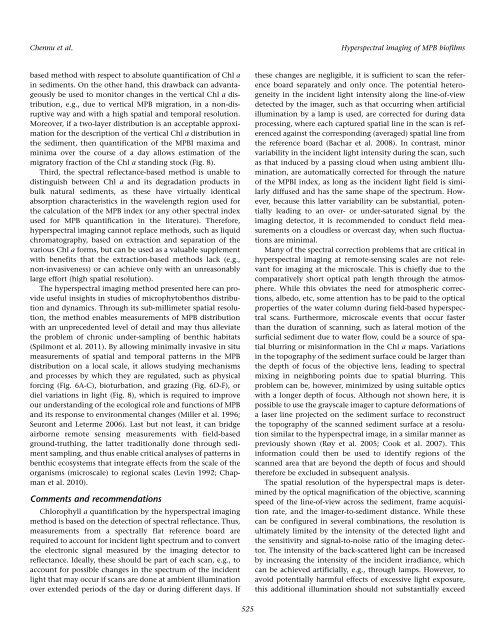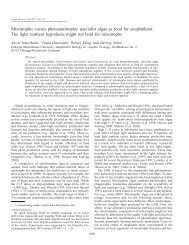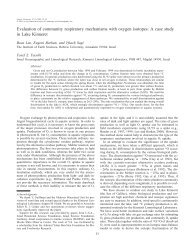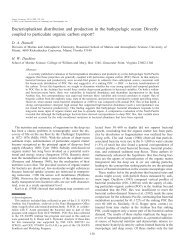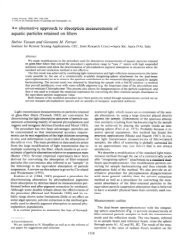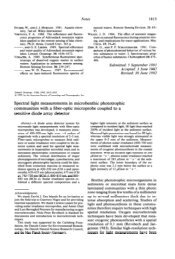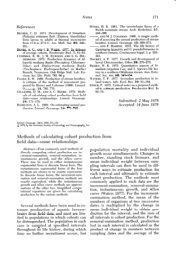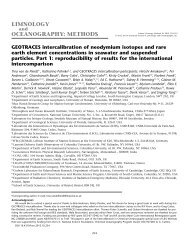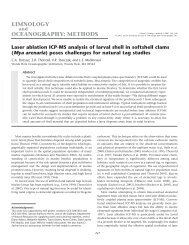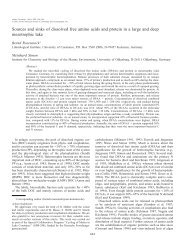Arjun Chennu, Paul Färber, Nils Volkenborn, Mohammad ... - ASLO
Arjun Chennu, Paul Färber, Nils Volkenborn, Mohammad ... - ASLO
Arjun Chennu, Paul Färber, Nils Volkenborn, Mohammad ... - ASLO
You also want an ePaper? Increase the reach of your titles
YUMPU automatically turns print PDFs into web optimized ePapers that Google loves.
<strong>Chennu</strong> et al.<br />
Hyperspectral imaging of MPB biofilms<br />
based method with respect to absolute quantification of Chl a<br />
in sediments. On the other hand, this drawback can advantageously<br />
be used to monitor changes in the vertical Chl a distribution,<br />
e.g., due to vertical MPB migration, in a non-disruptive<br />
way and with a high spatial and temporal resolution.<br />
Moreover, if a two-layer distribution is an acceptable approximation<br />
for the description of the vertical Chl a distribution in<br />
the sediment, then quantification of the MPBI maxima and<br />
minima over the course of a day allows estimation of the<br />
migratory fraction of the Chl a standing stock (Fig. 8).<br />
Third, the spectral reflectance-based method is unable to<br />
distinguish between Chl a and its degradation products in<br />
bulk natural sediments, as these have virtually identical<br />
absorption characteristics in the wavelength region used for<br />
the calculation of the MPB index (or any other spectral index<br />
used for MPB quantification in the literature). Therefore,<br />
hyperspectral imaging cannot replace methods, such as liquid<br />
chromatography, based on extraction and separation of the<br />
various Chl a forms, but can be used as a valuable supplement<br />
with benefits that the extraction-based methods lack (e.g.,<br />
non-invasiveness) or can achieve only with an unreasonably<br />
large effort (high spatial resolution).<br />
The hyperspectral imaging method presented here can provide<br />
useful insights in studies of microphytobenthos distribution<br />
and dynamics. Through its sub-millimeter spatial resolution,<br />
the method enables measurements of MPB distribution<br />
with an unprecedented level of detail and may thus alleviate<br />
the problem of chronic under-sampling of benthic habitats<br />
(Spilmont et al. 2011). By allowing minimally invasive in situ<br />
measurements of spatial and temporal patterns in the MPB<br />
distribution on a local scale, it allows studying mechanisms<br />
and processes by which they are regulated, such as physical<br />
forcing (Fig. 6A-C), bioturbation, and grazing (Fig. 6D-F), or<br />
diel variations in light (Fig. 8), which is required to improve<br />
our understanding of the ecological role and functions of MPB<br />
and its response to environmental changes (Miller et al. 1996;<br />
Seuront and Leterme 2006). Last but not least, it can bridge<br />
airborne remote sensing measurements with field-based<br />
ground-truthing, the latter traditionally done through sediment<br />
sampling, and thus enable critical analyses of patterns in<br />
benthic ecosystems that integrate effects from the scale of the<br />
organisms (microscale) to regional scales (Levin 1992; Chapman<br />
et al. 2010).<br />
Comments and recommendations<br />
Chlorophyll a quantification by the hyperspectral imaging<br />
method is based on the detection of spectral reflectance. Thus,<br />
measurements from a spectrally flat reference board are<br />
required to account for incident light spectrum and to convert<br />
the electronic signal measured by the imaging detector to<br />
reflectance. Ideally, these should be part of each scan, e.g., to<br />
account for possible changes in the spectrum of the incident<br />
light that may occur if scans are done at ambient illumination<br />
over extended periods of the day or during different days. If<br />
these changes are negligible, it is sufficient to scan the reference<br />
board separately and only once. The potential heterogeneity<br />
in the incident light intensity along the line-of-view<br />
detected by the imager, such as that occurring when artificial<br />
illumination by a lamp is used, are corrected for during data<br />
processing, where each captured spatial line in the scan is referenced<br />
against the corresponding (averaged) spatial line from<br />
the reference board (Bachar et al. 2008). In contrast, minor<br />
variability in the incident light intensity during the scan, such<br />
as that induced by a passing cloud when using ambient illumination,<br />
are automatically corrected for through the nature<br />
of the MPBI index, as long as the incident light field is similarly<br />
diffused and has the same shape of the spectrum. However,<br />
because this latter variability can be substantial, potentially<br />
leading to an over- or under-saturated signal by the<br />
imaging detector, it is recommended to conduct field measurements<br />
on a cloudless or overcast day, when such fluctuations<br />
are minimal.<br />
Many of the spectral correction problems that are critical in<br />
hyperspectral imaging at remote-sensing scales are not relevant<br />
for imaging at the microscale. This is chiefly due to the<br />
comparatively short optical path length through the atmosphere.<br />
While this obviates the need for atmospheric corrections,<br />
albedo, etc, some attention has to be paid to the optical<br />
properties of the water column during field-based hyperspectral<br />
scans. Furthermore, microscale events that occur faster<br />
than the duration of scanning, such as lateral motion of the<br />
surficial sediment due to water flow, could be a source of spatial<br />
blurring or misinformation in the Chl a maps. Variations<br />
in the topography of the sediment surface could be larger than<br />
the depth of focus of the objective lens, leading to spectral<br />
mixing in neighboring points due to spatial blurring. This<br />
problem can be, however, minimized by using suitable optics<br />
with a longer depth of focus. Although not shown here, it is<br />
possible to use the grayscale imager to capture deformations of<br />
a laser line projected on the sediment surface to reconstruct<br />
the topography of the scanned sediment surface at a resolution<br />
similar to the hyperspectral image, in a similar manner as<br />
previously shown (Røy et al. 2005; Cook et al. 2007). This<br />
information could then be used to identify regions of the<br />
scanned area that are beyond the depth of focus and should<br />
therefore be excluded in subsequent analysis.<br />
The spatial resolution of the hyperspectral maps is determined<br />
by the optical magnification of the objective, scanning<br />
speed of the line-of-view across the sediment, frame acquisition<br />
rate, and the imager-to-sediment distance. While these<br />
can be configured in several combinations, the resolution is<br />
ultimately limited by the intensity of the detected light and<br />
the sensitivity and signal-to-noise ratio of the imaging detector.<br />
The intensity of the back-scattered light can be increased<br />
by increasing the intensity of the incident irradiance, which<br />
can be achieved artificially, e.g., through lamps. However, to<br />
avoid potentially harmful effects of excessive light exposure,<br />
this additional illumination should not substantially exceed<br />
525


